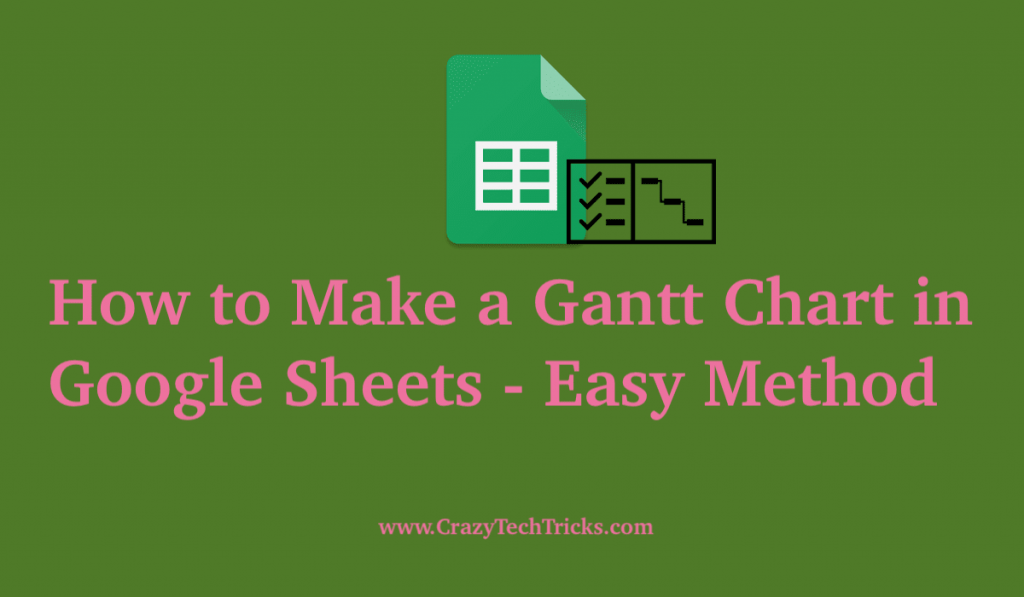Hello friends, Today I will tell you a method on how to make a Gantt chart in Google sheets. Users can create a dynamic Gantt chart. You can even use several types of formatting in the Gantt chart. You can customize any report using the Gantt chart on your computer. Users can remotely edit the Gantt chart using Google docs.
What is Gantt Chart?
Gantt charts are a really great organizational tool that is used to visually represent the completion of a project according to the predetermined timeline of the project. Gantt charts are a really useful asset while working on a predefined timeline of a project or process. It helps you to keep a track of time and work systematically.
Google Sheets provides the feature to make spreadsheets and charts according to the demand of user and thus you can make Gantt chart with the use of Google Sheets too.
Read more: How to Create a Graph in Google Sheets
The benefit of using Google Sheets for making Gantt charts is the fact that it enables collaboration with other individuals easy and really flexible through the use of Google Cloud. It allows editing and updation of the sheet by different users flexibly, that may be working in different timelines and from different locations. Learn how to make a Gantt chart in Google Sheets below.
How to Make a Gantt Chart in Google Sheets
Creating a Gantt chart in Google sheet is a simple process that can get confusing if the terminology is not followed through. So make sure to follow the steps thoroughly.
- Navigate to “Google Sheets” and open up Sheets.
- Start filling in your “Tasks”, “Start Date” and “End Date” in separate columns. Start with filling in your tasks and then follow through by adding dates. The format of the dates can be DD-MM-YYYY or MM-DD-YYYY. In the image above, the format for the date is MM-DD-YYYY.
- Add “Timeline” and “Status” columns to your spreadsheet.
- After adding the “Timeline” and “Status” columns in your spreadsheet, apply a Data validation on the status columns to keep a check of different tasks. You can add Data validation to the column by right-clicking on the top of it, and then navigate or scroll down to “Data validation” and click on it. After you click, a tab will open up, under the “Criteria” section choose the option of “List of items” and then add the status that you would want to note down. Add them in the bar next to “Criteria” by separating them by a comma.
- The “Sparkline” function.
Sparkline is preset in Google Sheets that allows the user to make a bar graph inside a column cell. You can use the SPARKLINE function in the formulas tab to do so.
Use the sparkline function to make a bar graph and then make a Gantt chart in Google Sheets. - Using the “SPARKLINE” function.
Write in the functions tab “=SPARKLINE({},{})”. In the first curly bracket, we write the logic for calculation of the bar graph from the data that we have and in the second pair of the curly brackets we define the type of graph we need.
We calculate the difference in the dates which is then represented as bars that shows the amount of work done or completed. This difference is used to make the Gantt chart out of the data calculated. Write the following equation on the D4 of the sheet.
“=SPARKLINE({int(B4)–int($B$2),int(C4)–int(B4)},{“charttype”,“bar”;“color1”,“white”;“color2”,“black”;“max”,int($C$2)–int($B$2)})”Now, let’s understand. We make two horizontal bars with the help of the dates that we have set for our project. We do so by subtracting the date of tasks by the day of starting of project(int(B4)-int($B$2)) and subtracting the timeline divided for the task(int(C4)-int(B4)). We use the “$” sign to fix the cell that we are using to gather the data from.
The second section of the function is used to specify the visual components of the graph. You can select the type of chart required which in this case was the “bar” chart. And moreover, you can control the type of color you want to display your bar graph in. - Copy the function to other cells.
Select the D4 cell and click on the blue block on the bottom right corner. Hold the block and drag it to all the cells that you need to make the chart for. - Make your chart more dynamic.
You can make your chart more dynamic with the use of if statements, where you can configure the color of your graph with the results from your “Status” column.
To do so, change the “color2” section of the Sparklist to the code below:
“color2”,if(E4=“Complete”,“red”,“green”);”
This is an “if” statement that changes the color of the graph depending on the value of the Status column, so if the status of the task is “Complete” then the graph color will automatically turn to red color.
Must Read: How to Add Page Numbers in Google Docs
Conclusion
The use of Google sheets is versatile and it can be used to make different types of spreadsheets. Gantt chart is one of the many things you can make in Google sheets to improve the productivity of your project work. The article tells you about the process of making a Gantt chart and how you can use it to make your charts more dynamic and fun to work with.
Leave a Reply